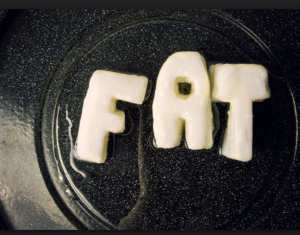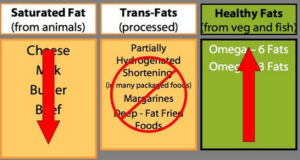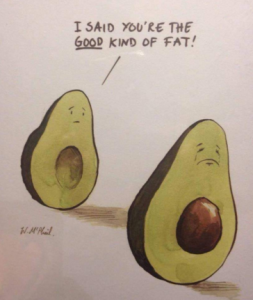
Ah yes, here we are on the tail end of winter, getting ready for warm weather, beach season, bro tanks and bikinis. That means I can’t eat fat right? Because I mean everyone knows that fat will make me fat, right?? WRONG. Don’t forget that fat, (sometimes called lipid) is a macronutrient just like carbohydrate and protein, and is absolutely essential for health.
Dietary fat (the kind you eat) is really just one of many types of a broader category of substances called lipids. For the purposes of this post, though, I’ll just stick to calling it fat, as well as Triacylglycerol, aka TAG. Triacylglycerol is the major form in which the body stores fat, and it accounts for 95% of the fat that is consumed in the diet.
One of the reasons that fat has such a bad reputation is because of its caloric value. One gram of fat carries 9 calories, which is more than double the amount provided by carbohydrate and protein, being 4 calories. Because of this, people often try to limit fat intake to reduce their total calorie intake. While this can be fine and healthy thing to do, we can’t forget that the body absolutely needs fat to work properly.
Fat can be found in various forms in different foods, but primary sources of fat in the diet are oils, cheese, fatty protein, butters, nuts, and eggs. All of these sources have differing types of fat, and I’ll talk more about those in a bit.
Fat serves many functions in the body, including energy storage, protection, and a critical role as a precursor for many other molecules in the body. We eat fat primarily to get what are called fatty acids. Fatty acids are basically long chains of carbon and hydrogen that can be used to build other substances that the body needs, or be broken down to give us energy. Just like with protein, certain fatty acids are called essential fatty acids. These fatty acids are essential because the body can’t make them, so they have to be consumed (Gropper & Smith, 138).
The two essential fatty acids are called Linoleic Acid (aka Omega 6), and Linolenic Acid (Omega 3). These fatty acids are unique because all other fatty acids that the body needs can be synthesized with these two as a starting point. In the United States, we tend to over consume Omega 6, and under consume Omega 3, hence the popularization of Omega 3 supplements. Omega 3 is most commonly found and consumed in fish oil, and its primary health benefits involve reducing inflammation, lowering the amount of lipids in the blood, as well as helping prevent blood clot formation (Gropper & Smith, 139).
So I’ve heard about saturated fat, unsaturated fat, and trans fat..what are those?
Bare with me here, I’m going to have to talk about a little bit of chemistry to explain this to you. Remember how I said that fatty acids are long strings of carbon and hydrogen? Well, a saturated fat is one that has the maximum number of hydrogens that it can. These hydrogens take up space, so the fatty acid is very rigid and orderly. Consequently, it doesn’t flow well and is solid at room temperature. We get these fats mostly from animal products, processed foods, and butter. There is debate about whether or not saturated fat is quite as bad as everyone seems to think it is, but throughout the nutrition community it is still commonly accepted that saturated fat should be limited in the diet.

Unsaturated fat, on the other hand, does not have the maximum number of hydrogens that it can. Because of this, the fatty acid is more fluid and is liquid at room temperature. We get these fats mostly from plant oils like canola oil and olive oil.
Finally, trans fat is a kind of fat that is man made. I’ll spare you the chemistry, but basically trans fat is the product of a process called partial hydrogenation, where hydrogen is added to a fatty acid to make it more solid (Gropper & Smith, 138). Trans fat has been associated with heart disease risk, and as a result, trans fat is on its way out of food. The FDA recently announced that trans fat is not “generally recognized as safe” and will be removed from the United States food supply in the near future.
It is recommended that one consume 10%-35% of their calories per day from fat, with most of these fats being unsaturated fats. Good sources of these unsaturated fats are vegetable oil, canola oil, olive oil, almonds, and avocados.

Here’s a quick summary of basic fat knowledge:
Fat:
- Very important for body protection, insulation and building blocks
- Can be saturated (solid at room temperature) or unsaturated (liquid at room temperature)
- 2 essential fatty acids are linoleic acid (Omega 6) and linolenic acid (Omega 3)
- 9 calories per gram
- Should be 10% – 35% of daily calorie intake
- Eat more unsaturated fats from plant oils, almonds, avocados
References
Gropper, S. A., Smith, J. L., & Groff, J. L. (2009). Advanced nutrition and human metabolism. Australia: Wadsworth/Cengage Learning.
